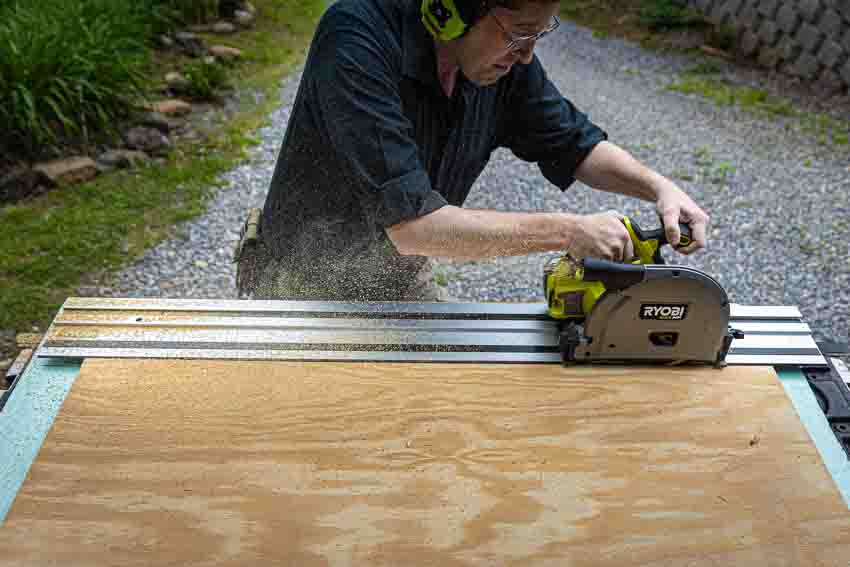Imagine being able to effortlessly cut through materials of any thickness with precision and ease. With “The Cutting Power of a Track Saw,” you can bring this fantasy to life. This revolutionary product offers the ability to achieve clean and accurate cuts, making it ideal for both professionals and DIY enthusiasts. Say goodbye to the limitations of traditional saws and experience the unmatched versatility of “The Cutting Power of a Track Saw.” Whether you’re tackling a small home project or working on a large-scale construction job, this tool will exceed your expectations and revolutionize your cutting experience.
What is a Track Saw?
Definition
A track saw, also known as a plunge saw, is a versatile and efficient cutting tool commonly used in woodworking and construction projects. It is designed to make precise and clean cuts on various types of materials, particularly sheet goods like plywood, MDF, and melamine. What sets a track saw apart from other saws, such as circular saws, is its unique operating mechanism and the use of a guide rail or track that ensures straight and controlled cuts.
Advantages
Track saws offer several advantages over traditional circular saws. Firstly, they provide increased precision and accuracy due to the guiding system provided by the track. The track ensures consistent straight cuts, eliminating the need for additional measuring and marking. Secondly, track saws minimize splintering and tear-out, resulting in cleaner cuts with minimal or no additional sanding required. Lastly, track saws are highly portable and can be easily transported to job sites, making them a convenient choice for contractors and DIY enthusiasts alike.
Components
A typical track saw consists of several key components. The main body houses the motor and cutting mechanism, while the base plate provides stability and support. The guide rail, or track, attaches to the base plate and serves as the guiding system for the saw. The track has a non-slip surface that helps keep the saw stable during operation. Most track saws also feature an adjustable depth stop, allowing users to control the cutting depth, and a bevel adjustment mechanism for making beveled cuts. The accessories that come with a track saw may vary, but commonly include dust extraction ports, anti-splinter strips, and additional guide tracks of different lengths.
How a Track Saw Works
Operating Mechanism
The operating mechanism of a track saw is relatively straightforward. When the saw is turned on, the motor spins a blade, which protrudes through a slot in the base plate. The base plate rests on the guide rail, which has a special groove that the saw blade follows. As the saw is pushed forward along the track, the blade cuts through the material, guided by the track. The depth stop can be adjusted to control the cutting depth, allowing for precise and consistent cuts. This mechanism ensures that the saw moves in a straight line, resulting in accurate and splinter-free cuts.
Comparisons with Circular Saws
While circular saws are also popular tools for cutting sheet materials, track saws offer distinct advantages. Circular saws typically require additional measuring and marking to ensure straight cuts, whereas track saws eliminate this step by relying on the precise guiding system of the track. Circular saws also tend to produce more splintering and tear-out, especially on fragile materials like veneered plywood, whereas track saws significantly reduce these issues. Additionally, track saws are designed for plunge cutting, allowing them to start cuts in the middle of materials, a task that is challenging with circular saws.
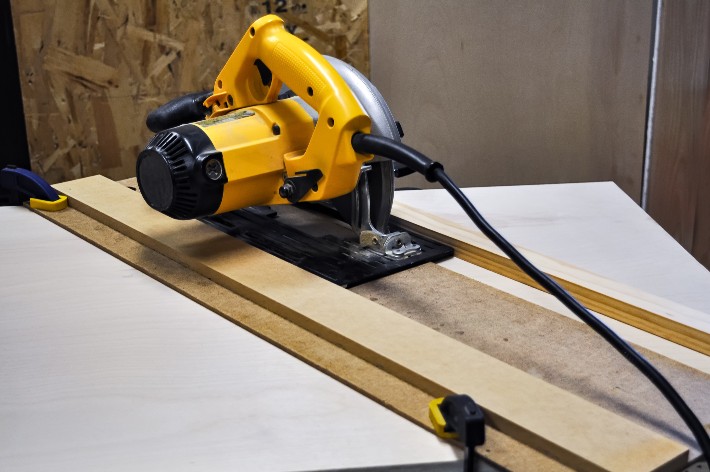
This image is property of www.woodsmith.com.
Key Features and Specifications
Cutting Depth
The cutting depth is a crucial specification to consider when choosing a track saw. It determines how thick of a material the saw can effectively cut. Most track saws have a maximum cutting depth between 2.5 and 3 inches, which is ideal for most sheet goods commonly used in woodworking and construction projects. However, some specialized track saw models may offer a greater cutting depth for heavy-duty applications.
Cutting Width
In addition to cutting depth, the cutting width is another essential specification to consider. It refers to the maximum width of material that the track saw can accurately and cleanly cut. The cutting width typically ranges from 10 to 12 inches, allowing for efficient and precise cuts on standard-sized sheet materials. However, it’s important to ensure that the track saw you choose can handle the width of the materials you typically work with.
Motor Power
The motor power of a track saw determines its cutting efficiency and performance. It is usually measured in amps or horsepower (HP). Higher motor power generally translates to better cutting performance, especially when working with denser or thicker materials. While track saws typically have motor powers ranging from 10 to 15 amps or 1.5 to 2.5 HP, it’s important to consider your specific cutting needs and the materials you work with when selecting a track saw with the appropriate motor power.
Blade Type
The type of blade used in a track saw is crucial for achieving clean, precise, and efficient cuts. Most track saws come with a standard carbide-tipped blade, which is suitable for cutting a wide range of materials, including plywood, MDF, and solid wood. However, different blades may be required for cutting other materials like metal or plastic. Consider the blade options and compatibility of the track saw you are considering, as well as the ease of blade replacement and availability of different blade types.
Bevel Capacity
The bevel capacity refers to the ability of a track saw to make beveled cuts, where the blade is tilted at an angle to the surface of the material being cut. While not all track saws offer bevel capacity, it can be a valuable feature for certain applications, such as creating chamfers or beveled edges. If you anticipate the need for beveled cuts in your projects, choose a track saw with an adjustable bevel capacity.
Choosing the Right Track Saw
Considerations
When choosing a track saw, several factors should be taken into consideration. Firstly, consider the intended use of the saw. Are you planning to use it primarily for woodworking projects or for heavier-duty construction tasks? This will help you determine the necessary power, cutting depth, and cutting width. Additionally, consider the frequency and portability requirements of your projects. If you frequently work on job sites or require a highly portable tool, opt for a lightweight and compact track saw. Finally, take into account your budget and balance it with the desired features and specifications of the track saw.
Budget
Setting a budget is an important step in choosing a track saw. Track saws are available in a wide price range, with basic models suited for hobbyists and entry-level professionals, as well as high-end models designed for heavy-duty use. Evaluate your needs and prioritize the features and specifications that are most important for your projects. Ensure that the track saw you choose fits within your budget while providing the desired cutting capabilities and durability.
Intended Use
Consider the type of projects that you will be undertaking with the track saw. If you mainly work on smaller woodworking projects or require precise cuts on delicate materials, a track saw with a lower motor power and cutting capacity may suffice. However, if you frequently work on construction sites or handle larger materials, opt for a track saw with a more powerful motor and a larger cutting capacity to ensure efficient and accurate cuts.
Blade Compatibility
Ensure that the track saw you choose is compatible with a variety of blades suitable for different materials and cutting tasks. Check if the track saw can accommodate standard-sized blades and if specialized blades are readily available for specific applications. Having the flexibility to change blades according to your needs will enhance the versatility of the track saw and allow you to tackle a wider range of projects.
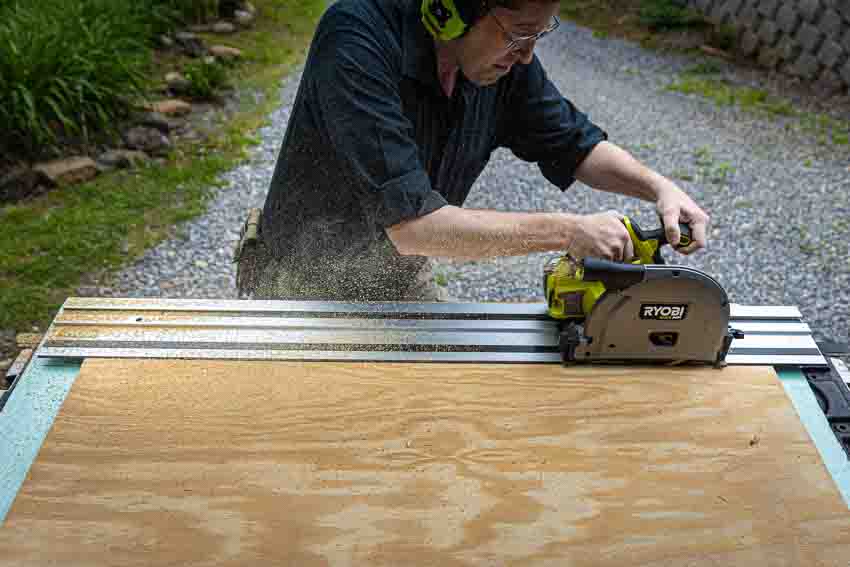
This image is property of www.protoolreviews.com.
Benefits of Using a Track Saw
Clean and Splinter-Free Cuts
One of the most significant advantages of using a track saw is the ability to achieve clean and splinter-free cuts. The track acts as a guide, ensuring that the blade follows a straight path and minimizes the chances of the material splintering or tearing. This eliminates the need for additional sanding or finishing to achieve smooth edges, saving both time and effort. Whether you’re working on cabinetry, furniture, or flooring, a track saw will consistently produce clean and professional-looking cuts.
Portability and Convenience
Track saws are highly portable and convenient to use. The combination of a lightweight design and the ability to detach the track from the saw makes transportation and storage hassle-free. Whether you’re working on a job site or moving between different locations in your workshop, the portability of a track saw allows for greater flexibility and ease of use compared to larger and less portable cutting tools.
Accurate and Precise
The guiding system provided by the track ensures accurate and precise cuts, eliminating the potential for human error when cutting freehand with a circular saw. The track acts as a reference point, ensuring that each cut is consistent and in-line with your intended measurements. This is particularly useful when working on projects that require a high level of precision, such as cabinetry or furniture making. With a track saw, you can trust that your cuts will be accurate and fit together seamlessly.
Ideal for Breaking Down Sheet Materials
Track saws excel at cutting large sheet materials, such as plywood or MDF. Traditional methods of breaking down sheet goods often involve relying on a table saw or a circular saw with a straightedge guide, which can be cumbersome and potentially unsafe. Using a track saw eliminates these challenges by providing a safe and efficient method for breaking down large sheets into smaller, more manageable pieces. Whether you’re working on flooring installations, trim work, or panel sizing, a track saw will streamline the process and ensure precise cuts.
Safety Precautions and Best Practices
Eye and Ear Protection
Safety should always be a top priority when operating any power tool, including track saws. It is essential to wear proper eye protection, such as safety glasses or goggles, to shield your eyes from flying debris. Additionally, using ear protection, such as earmuffs or earplugs, can help minimize the risk of hearing damage from prolonged exposure to loud sawing noises.
Work Area Setup
Prepare your work area before operating a track saw. Keep the area clean and free of clutter to avoid tripping hazards. Ensure that there is adequate lighting to clearly see the cutting line and track. If working outside, be mindful of weather conditions that could affect your safety or the performance of the track saw.
Clamping and Securing Materials
To prevent materials from shifting or sliding during cutting, it is crucial to securely clamp them down or use appropriate methods of securing them to the work surface. This will reduce the risk of accidental slips or kickbacks. Take the time to properly set up and secure the material before making any cuts, ensuring both your safety and the accuracy of the cuts.
Proper Handling and Operation
Follow the manufacturer’s instructions and recommendations for safe handling and operation of the track saw. Grip the saw firmly with both hands, keeping your fingers away from the cutting area. Never force the saw through the material; instead, let the blade and the track’s guiding system do the work. Always maintain full concentration and avoid distractions while operating the track saw to minimize the risk of accidents.

This image is property of empire-s3-production.bobvila.com.
Common Applications for Track Saws
Cabinet Making
Track saws are widely used in cabinet making due to their ability to make precise cuts on sheet materials. Whether it’s cutting cabinet components, shelves, or drawers, a track saw ensures accurate and clean cuts, resulting in a professional finish.
Furniture Building
Track saws are invaluable tools for furniture builders. They excel at breaking down large sheet materials into manageable pieces for constructing furniture frames, tabletops, and shelves. The precision and cleanliness of cuts produced by track saws contribute to the overall quality and craftsmanship of furniture pieces.
Flooring Installation
Track saws are essential for flooring installations, especially when cutting laminate, engineered wood, or vinyl flooring materials. The ability to make accurate and splinter-free cuts ensures clean edges and tight-fitting joints, resulting in a seamless and professional-looking flooring installation.
Trim Work
When it comes to trim work, track saws offer exceptional precision and control. From baseboards to crown molding, track saws allow for accurate cuts with clean edges, ensuring seamless transitions and professional-looking trim installations.
Panel Sizing
Track saws are particularly useful for cutting large panels, such as those used in wall paneling or doors. By using the track as a guide, track saws enable precise and consistent cuts, ensuring that the panels fit together seamlessly for a polished and professional result.
Tips and Techniques for Optimal Cutting
Aligning the Track
Accurate cuts rely on a properly aligned track. Before making any cuts, ensure that the track is securely attached to the material and aligned parallel to the desired cutting line. Double-check the alignment to ensure straight cuts and avoid compromising the accuracy of your project.
Using Guide Blocks
Guide blocks can be used to enhance the stability and accuracy of your cuts. These can be clamped to the material on either side of the track, providing additional support and preventing the material from shifting during cutting. Guide blocks are especially useful when working on longer cuts or with materials prone to movement, ensuring consistent and clean results.
Controlling the Feed Rate
To achieve optimal cutting results, it is essential to control the feed rate of the track saw. Pushing the saw too quickly may lead to rougher cuts, while pushing too slowly can cause overheating and potentially damage the blade. Find a comfortable and consistent feed rate that allows the blade to make clean and efficient cuts without compromising accuracy.
Avoiding Tear-Out
Tear-out occurs when the material splinters or chips during the cutting process. To minimize tear-out, adjust the depth stop to just slightly deeper than the material being cut. Additionally, using a fine-toothed blade with a slow feed rate can help prevent tear-out, resulting in cleaner and more professional-looking cuts.
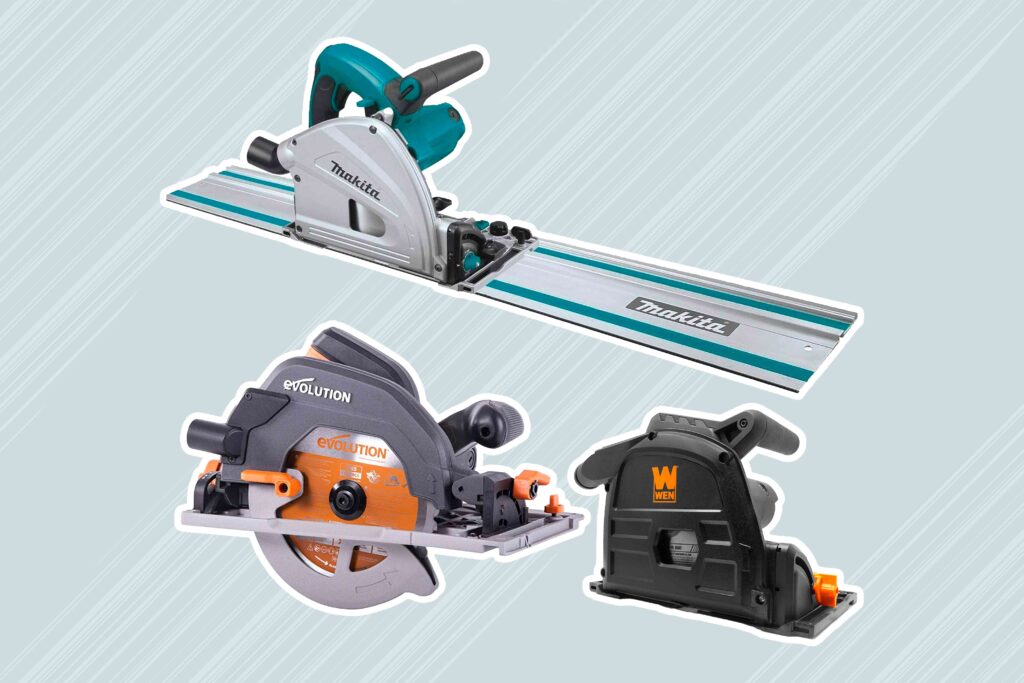
This image is property of www.thespruce.com.
Maintenance and Care
Cleaning the Tracks
Regularly cleaning the tracks of your track saw is essential for optimal performance and accuracy. Remove any debris or sawdust accumulated in the track to ensure smooth movement of the saw along the rail. Use a brush or compressed air to clean out any residue, and wipe down the track with a dry cloth to keep it in good condition.
Blade Replacement
Over time, blades can become dull or damaged, leading to less efficient cuts and increased strain on the motor. Replace the blade when necessary to maintain the quality and performance of your track saw. Follow the manufacturer’s instructions for blade replacement, ensuring that the new blade is compatible with your track saw model.
Lubrication
Some track saw models may require occasional lubrication to ensure smooth operation. Refer to the manufacturer’s recommendations for the appropriate lubricant and application method. Regularly lubricating the moving parts of the saw, such as the depth adjustment mechanism and bevel adjustment, will help prevent unnecessary wear and ensure smooth and precise operation.
Storage
When not in use, store your track saw in a clean and dry area, preferably in a protective case or cover to prevent dust and debris from accumulating on the tool. Avoid exposing the saw to extreme temperatures or humidity, as this can affect its performance and lifespan. Proper storage will help prolong the life of your track saw and ensure that it is ready for use whenever you need it.
Conclusion
Summary of Track Saw Benefits
Track saws offer numerous advantages, including precise and splinter-free cuts, portability and convenience, and the ability to handle sheet materials with ease. The operating mechanism of a track saw, guided by a track, ensures accurate and straight cuts, making it an ideal tool for various woodworking and construction applications.
Final Thoughts
Whether you’re a professional woodworker, a DIY enthusiast, or a contractor in need of a versatile cutting tool, a track saw is a valuable addition to your arsenal. With its clean and accurate cutting capabilities, portability, and ease of use, a track saw will not only streamline your projects but also elevate the quality and precision of your work. Consider your specific cutting needs, evaluate the features and specifications of different track saw models, and choose the one that best suits your requirements. Happy cutting!
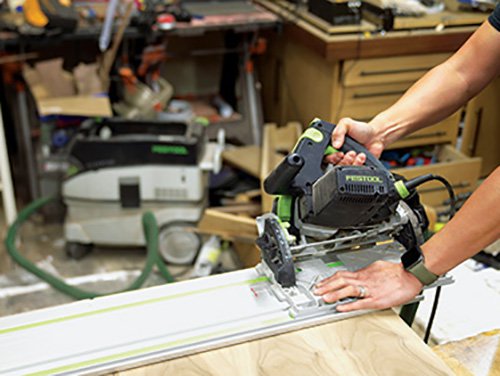
This image is property of www.rockler.com.
